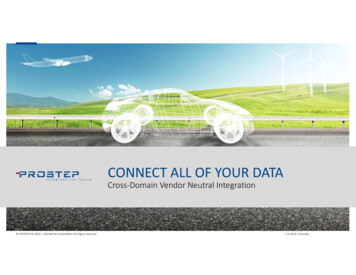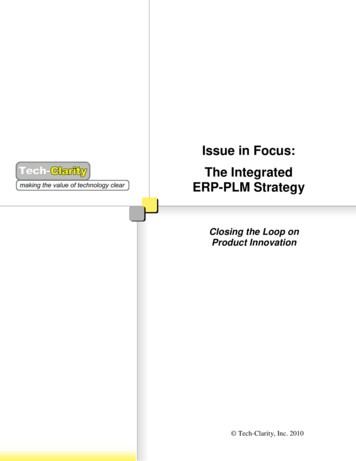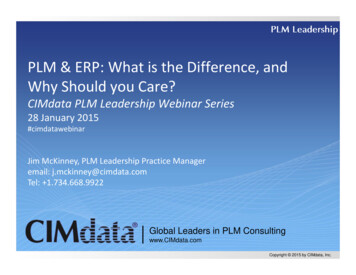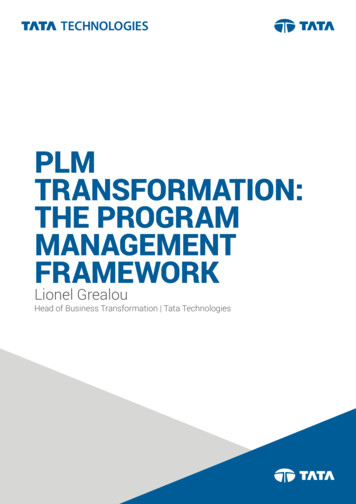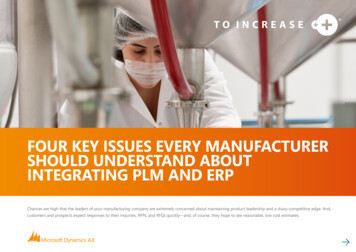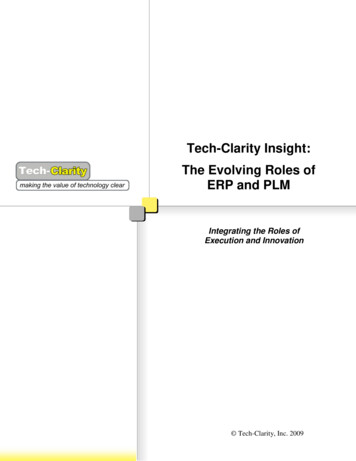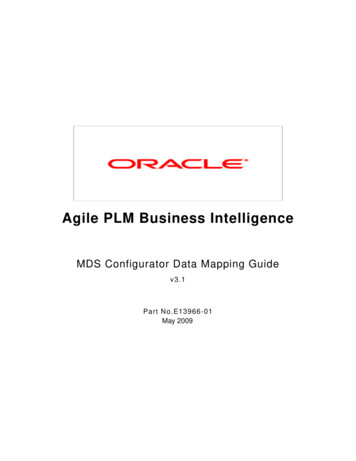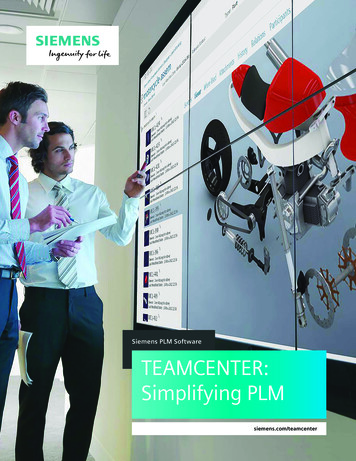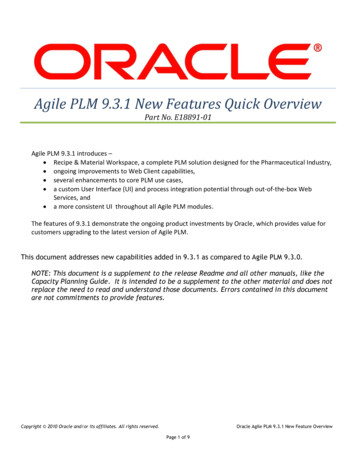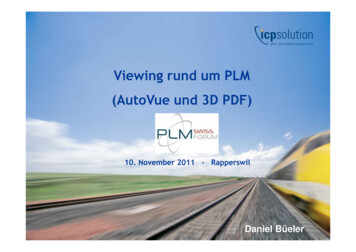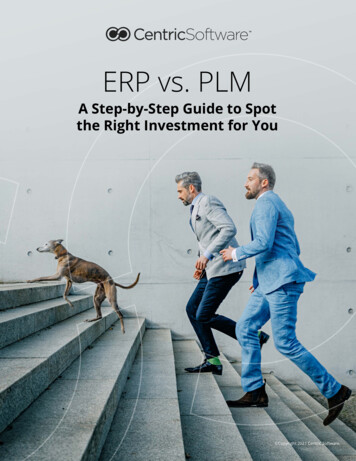
Transcription
ERP vs. PLMA Step-by-Step Guide to Spotthe Right Investment for You Copyright 2021 Centric Software.
Companies continuously face toughdecisions when it comes to technologyinvestment. One such decision:Is it better to implement a newERP / upgrade an existing ERP system— OR —will a PLM solution return as much ormore for the time and money invested?It is prudent to investigate both scenarios.In this document we will explore eachtechnology in turn and review situationswhere the first priority should beupgrading ERP, and situations where thefirst priority should be upgrading PLM. Ourstep-by-step guide will help you decidewhat is best for your company. 2021 Centric Software Inc.1
Technology as a competitive edgeToday’s fast-moving retailers and brands must get trend-right products to market faster and moreefficiently than ever. And with more product cycles squeezing into every season, these companiesknow that building and sustaining brand equity with high-quality, innovative products is just asimportant as speed to market.Searching for a competitive edge, executives look to different kinds of technology to serve as thefoundation for digital transformation initiatives to achieve an operational or strategic goal.Two key technologies—which system delivers better ROI?Two key technologies, Enterprise Resource Planning (ERP) and Product Lifecycle Management(PLM), have become foundation systems for fast-moving consumer goods brands, retailersand manufacturers. While each technology brings unique value to an organization, decidingwhich solution is the better investment—and when—can have a dramatic impact on return oninvestment (ROI).Inventory, warehouse and fulfillment managers, financial teams and others all work directly withERP systems. Their teams may suffer ill effects if critical functionalities are missing or impedingtheir efforts. With an upgraded ERP system, they may argue, they could provide more timelyreporting or more accurate informational updates, thereby enhancing the executive decisionmaking process.On the other hand, the entire product development organization of many consumer productcompanies functions with a cobbled-together system of spreadsheets, emails and docs, orwith a Product Data Management (PDM) system the company purchased years ago to vaultproduct data.In some companies, the teams—design, engineering, product development, sourcing, quality,merchandising, and marketing—may say that they can’t continue using incumbent systemsand need to upgrade to a modern PLM solution. In other companies, those departments don’teven realize the power of PLM and will be pleasantly amazed by the increased efficiency thatPLM brings.Which system is right for right now?Here’s a step-by-step guide to determine which one of these investmentswill give your organization a fast ROI and a competitive advantage amongindustry peers. 2021 Centric Software Inc.2
STEP1Get to Know the Lay of the LandERP vs. PLMAs stated, each solution has its respective benefits, which begs the question, “Which one is rightfor your company, right now?” To that end, let’s take a look at ERP vs. PLM and the characteristicsof each system.Characteristics of ERP vs. PLM systemsERPWHOWHAT Finance, sales, sourcing, manufacturing Design, product development, costing, planning,quality, suppliers Focuses on transactional history All the iterative, collaborative and creativeprocesses that make up the more vital elementsof a product’s lifecycle Oriented around business operations:customer service, finance, accounting,distribution, labor, manufacturingand more Takes a finalized product forwardfrom PLMHOWBENEFITSPLM Takes a product to store shelves,handling operational concerns like:logistics, warehousing, inventorymanagement, order fulfillment,allocate HR PLM supports the processes that: define thebrand, engage the consumer and differentiate thecompany’s products in the marketplace PLM sets the foundation for ERP Products are created in PLM, then picked up by ERP Clean data from PLM onwards is critical to thehealth and efficiency of the ERP Provides a single source of cost,margin, and other commercialinformation PLM reduces wasted time of valuable resourceswho no longer have to search for the latestproduct information ERP provides transactional data thatbusinesses can use to evaluate theirfinancial position and make informeddecisions about their future Cuts down on errors and delays Reduces threats to quality and controls costs Preserves margins Increases visibility to product development ERP takes transactional units to marketwith data that originates in PLMCONCLUSION ERP has a purposeful focus: cost, ship,sell, monitor, and repeat Without modern PLM, its potentialis limited New, modern PLM solutions are designedspecifically to manage shorter product lifecycles andhigh volumes of new product introductions These PLM systems meet the specific needs ofcompanies in the fashion, retail, footwear, luxury,outdoor, food & beverage, health & beauty andconsumer goods markets 2021 Centric Software Inc.3
STEP2Take InventoryGiven the specifics of both ERP and PLM technology, here are the top 5 signs that point towhich one to start with:ERP1You’ve outgrown your existing system2You can’t report your financials3You have inaccurate inventory4You have an overly customized/non-supported system5Users are working around it forwhatever reasonVSPLM1You’re maintaining the sameinformation in different places2Remote collaboration is challenging3Your pricing strategy is manual and/orreactionary4You’re too dependent on specific peopleto keep processes running smoothly5Your existing systems slow you downevery day 2021 Centric Software Inc.4
STEP3Determine if you need both ERP and PLMComparative impact of ERP and PLMFIGURE 1ERP systems are vital tools. In fact, it is unlikelythat a company can form and become fullyoperational without a basic ERP system. But PLMsystems manage the functions that define andenable brand development, market penetrationand corporate success. (See figure 1).PLM systems manage the critical “What” questions that steer the strategic successof a business and affect its margins and profitability. What products should we develop? What supplier should we work with? What materials and trims will we use?ERP systems manage “How Many/Where/When” questions that record and report transactions.PLM’s domain has a greater impact on margins and profitability than does that of ERP. 2021 Centric Software Inc.5
STEP4Should you start with PLM?5 points to consider when deciding whether or not to start with PLM:1QUICK WINS HAVE A HIGHER NET PRESENT VALUEFocus on projects that are relatively quick with a high return on investment: Projects that extend beyond 12-18 months require building towards speculativebusiness objectives Simplify your ROI discussion (remember the 80-20 Rule!) Consider both project and program cost2FOCUS ON VALUE DRIVERS Strategic initiatives that contribute to winning in the market Customer Centric (Feedback Loops/Innovation/Flexibility ) Strategic Sourcing (Quality/Time-to-Market )34 COGS (Material Management/Capacity Planning)CREATE MOMENTUM FOR CHANGE Identify projects that demonstrate success and leave the organization wanting moreTACTICAL DECISIONSPeople are often biased by shiny objects and lose sight of basic principles.Make sure to keep your eye on the prize: One version of the truth—the right data in the right place Get rid of spreadsheets Re-train before you re-implement Stay decision-focused5AMPLIFY YOUR ERP PROJECT ERP uses data that originates from PLM Clean data from PLM means healthy data into ERP A successful PLM implementation guarantees a higher success rate of your ERPimplementation 2021 Centric Software Inc.6
Detailing the impact of PLMToday, companies know that they need to make smart, cost-effective technology investments.Those investments must be able to provide short-term meaningful returns on PLM investments.How does PLM deliver ROI? Top line growth: increased income and sales up to 5% to 10%. Faster time to market: by days or weeks which results in increased sell through; 2% high sellthrough for each week cut from time to market. Reduced operating costs: reduced stock by 20-40% and cut down logistic costs by 10-15%. More new products to market: e.g., a fashion company can cut style creation time from half aday to 30 minutes. Accelerated development time: shorten development by days. Reduce data entry time bydays or weeks. Increased efficiency: decreased data errors by 20-30% and reduced product informationsearch time by approximately 30%. Improve supplier relationship: 20% decrease in questions from suppliers after initial techpack or product brief distribution. Less waste: cut material purchase errors by 30%. A modern PLM solution deploys in 3 to 4 months 2021 Centric Software Inc.7
Going Further: Integration of PLM and ERPOnce PLM is established, consider ERP integration for even more impact. Centric PLM hasintegrated with over 40 different ERP systems so you know we can integrate with yours.With integration to ERP, there are a few advantages: Build BOMs directly in Centric PLM and reduce data errors in ERP that cause costly mistakesand hold-ups. Make better-informed decisions with enhanced visibility, improved team collaboration anddecision making, to enable dynamic, ‘quick-response’ scenarios and proactively manage risk. Simultaneously manage many different types of collections and unique products with varyingdata intricacy, quantities, timelines and budgetary criteria at once and send that accurate,complex product data to ERP. Give users a unique environment where they can easily find all product related information—a single source of the truth. 2021 Centric Software Inc.8
Fashion, retail and consumer goods markets now accept PLM systemsas best practice. As more companies and industries adopt PLM, they arereaping tremendous productivity gains.PLM’s essential value is that it delivers a “single version of the truth” about a product to everyoneworking in any aspect of product development. People around the office, country and world canall work together in real time on the same products. They can seamlessly exchange informationwith everyone in the supply chain, including partners, manufacturers and compliance experts.All of this leads to improved efficiency, lower COGS, improved margins, increased speed tomarket and not to be overlooked, happier employees who can spend their days focusing on theimportant and rewarding parts of their jobs.An investment in PLM will deliver greater financial and strategic impact than will a comparableinvestment in ERP. Perhaps more importantly, that investment in PLM will deliver competitiveadvantage in a way that ERP cannot approach. 2021 Centric Software Inc.9
We Want to Hear From YouArmed with the information you’ve acquired, explorepossible next steps with us! Contact Centric Softwareto learn more or set up a demo tailored for yourindustry and company. Our experts would loveto discuss your unique situation and give you theirinsights from a company that has done 450 PLMimplementations representing over 2000 brands.CONTACT USwww.centricsoftware.com 2021 Centric Software, Inc.
Going Further: Integration of PLM and ERP Once PLM is established, consider ERP integration for even more impact. Centric PLM has integrated with over 40 different ERP systems so you know we can integrate with yours. With integration to ERP, there are a few advantages: Build BOMs directly in Centric PLM and reduce data errors in ERP that .
